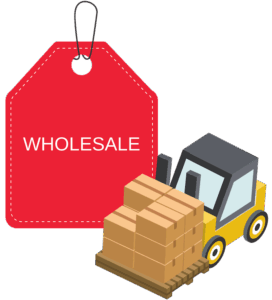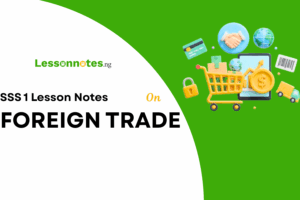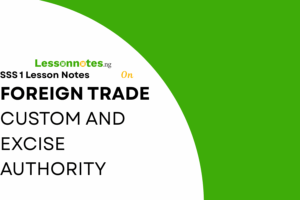Home Trade: Wholesale Trade SS1 Commerce Lesson Note
Download Lesson Note
Lesson Notes
Topic: Home Trade: Wholesale Trade

Wholesale trade (wholesaling) involves the buying of goods in large quantities from the producers or manufacturing and re-selling in small quantities to retailers. A wholesaler is a trader who purchases goods in large quantities from the manufacturer and sells them in small quantities to the retailers.
FUNCTIONS OF THE WHOLESALER
A. To the Manufacturer
- He gives useful information and advice to the manufacturer e.g. concerning the level of demand for goods etc.
- The wholesaler provides warehouse and storage facilities for storing goods, thereby helping the manufacturer to have enough space for further production.
- Preparation of commodities for sale: The wholesaler sometimes labels, packages, blends or brands the goods before he sells them.
- Advertising and promotion of goods: The wholesaler creates awareness for goods through advertising and sales promotion.
- The wholesaler finances the manufacturer by paying for goods in advance
- provision of transport facilities needed for the distribution of the goods.
- Quantity of bulk buying. The wholesaler buys in larger quantities, this encourages the manufacturer to produce more and thereby reap the advantages of large-scale production.
- The wholesaler bears part of the risks involved in the production and distribution of goods e.g. risk of a fall in price change in fashion, or deterioration of goods. Etc
- Quality control: The wholesaler may sometimes verify the quality of the products before distributing them i.e. grading of commodity products e.g. cocoa.
B. To the Retailer
- The wholesaler breaks bulk by selling in small quantities to the retailer.
- The wholesaler finances the retailer by granting him credits.
- The wholesaler sometimes provides advice and information on new goods, market trends
- Stabilization of prices: By storing goods in his warehouse and thereby regulating supply to the marker, the wholesaler keeps prices fairly stable for retailers.
- He provides the retailer with a variety of goods.
TYPES OF WHOLESALERS OR MIDDLEMEN
- General wholesalers
- Specialist wholesaler
- Cash and carry wholesalers
- Factors (or Mercantile Agents)
- Brokers
- Jobbers
- Del Credere Agents (wholesalers )
- Auctioneers
- Manufacturer Representative
- Commission Agents.
CHANNEL OF DISTRIBUTION
The channel of distribution describes the path through which goods move from the products to the consumer.
The channel of distribution for goods could be any of the following:
- Producer – Wholesaler – Retailers – Consumers
- Producer – Wholesaler – Consumers
- Producer – Retailers – Consumers
Producer – Agent – Retailer –
- Consumers – Producer – Agent – Consumers
FACTORS TO BE CONSIDERED BEFORE CHOOSING A PARTICULAR CHANNEL OF DISTRIBUTION OF A COMMODITY
- The type of nature of the commodity e.g. whether it is a perishable good or durable goods.
- Geographical consideration e.g. the location of customers.
- The existing and potential demand for the commodity i.e. the extent of demand for the product.
- How regular the demand for the product is.
- The number of retail outlets in an area.
- The producer’s capital, financial position, organizational ability and selling skills.
- The size of customers’ orders.
- The quantity of goods involved.
- The channel used by competitors.
- The cost implication of the channel being considered.
- The customs of the particular trade e.g. distribution of newspapers.
REASONS WHY MIDDLEMEN(WHOLESALERS/RETAILERS) ARE SOMETIMES OMITTED OR ELIMINATED FROM THE CHANNEL OF DISTRIBUTION
- When the producer is dealing with large orders from the customers.
- When perishable goods are involved, they cannot be passed through a long channel of distribution.
- Where the goods are technical, and therefore, after-sales e.g. repairs are likely to be involved.
- Where the producer operates his retail outlets e.g. FAMAD, Len nards.
- Where the consumer has ordered goods to his specification e.s special styles or customized orders.
- Where the manufacturers operate a mail order business.
- Where the goods involved are durable and have a low turnover ekg, furniture.
- Where the goods involved are expensive and the buyer has to pay in advance before it is manufactured by the producer e.g. ships, aeroplanes, plants.
- When new products are being introduced by the producer.
- When the producer wants to maintain fixed prices for his products.
- Where the goods are requested by Co-operative Consumers; Association i.e. where consumers have combined their orders.
WHY WHOLESALE PRICES ARE LOWER THAN RETAIL PRICES
- The wholesaler buys in bulk and at reduced prices.
- The wholesaler buys directly from the manufacturer.
- The wholesaler usually pays promptly or even sometimes pays in advance for goods therefore he buys at a cheaper rate.
- The wholesaler gets both a trade and cash discount.
- The retailer sells in units.
EFFECTS OR REASON WHY LARGE NUMBER OF MIDDLEMEN SHOULD NOT BE ENCOURAGED IN THE DISTRIBUTION OF GOODS
- They could increase the prices of goods.
- They cause artificial scarcity through hoarding of goods
- They cause price differences in different areas.
- They cause inflation.
- It could encourage the distribution of fake or substandard products.





















